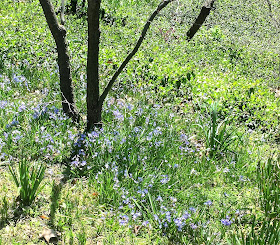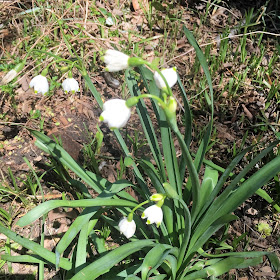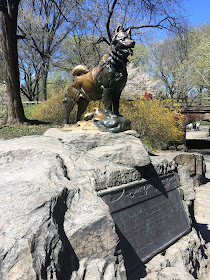"It is imperative that this population have open space and trees."
"On July 21, 1853, the New York State Legislature enacted into law the setting aside of more than 750 acres of land central to Manhattan Island to create America's first major landscaped public park; they would soon refer to it as 'the Central Park.' Frederick Law Olmsted and Calvert Vaux, the winners of the 1858 design competition for Central Park, along with other socially conscious reformers understood that the creation of a great public park would improve public health and contribute greatly to the formation of a civil society. Immediately, the success of Central Park fostered the urban park movement, one of the great hallmarks of democracy of nineteenth century."
I first became acquainted with Olmsted when I read The Devil in the White City by Erik Larson, a terrific book about the history of the 1893 Chicago World's Fair. Olmsted was an integral part of the team that designed the layout of the fair. That was 35 years after he did the planning for Central Park. In between he did projects like designing the campuses for Stanford, Berkeley, and Yale. Impressive guy.
Olmsted believed in using the natural features of a space. In Central Park that meant hills, rocky areas, swamps, streams, and 1,600 impoverished residents.

He incorporated most of the natural features; however, the residents--at least the human ones--were evicted.
We spent a day criss-crossing the length and width of this magical park. It is hard to believe that there is a space like this in the middle of the most populous city in the United States. We entered through the southwest corner:
Early April is a fabulous time to visit Central Park. It's the month when Mother Nature pulls all of her most beautiful clothes out of the closet.
No park is complete without a boatload of statuary. There are 29 (statues, not boats) in Central Park.
One of the oldest statues in the park and the first sculpture by an American artist to be placed in the park is The Indian Hunter (1866) by John Quincy Adams Ward:
Some of my favorite statues are of four authors lining a path at the south end of the "Mall," or the wide promenade that runs north-south through the middle of Central Park. This little section is known as "the Literary Walk."
The selection of authors reflects the taste of the day and includes Robert Burns (1880) and Walter Scott (1872):
Fitz-Greene who? Apparently he was a popular poet during his time.
I love the zigzagging branches of these old elms that are just beginning to leaf. They look like trees that should be surrounding a haunted house, but which are trying to disguise themselves with spring greenery:
I love that Alaskan sled dogs are being honored in Central Park.
And what's this? A tribute to the Three Musketeers? Nope. This fellow standing amid the cherry trees is The Pilgrim (1885). Inscribed on his pedestal are the words: "To commemorate the Landing of the Pilgrim Fathers on Plymouth Rock: December 21, 1620."
One of Alexander Hamilton, because how can one be in NYC and not visit Hamilton? (Okay, so I'd rather see the play, but the sculpture might have to do):
This delightful rendering of Hans Christian Anderson, author of the children's story The Ugly Duckling:
And Alice with all of her Wonderland friends:
In case you are wondering what the obelisk says:
The largest body of water in the park is the Reservoir, renamed the Jacqueline Kennedy Onassis Reservoir in 1994 a few months after the former first lady's death in honor of her many contributions to the city:
The reservoir is also a bird sanctuary and houses at least twenty species of waterbirds:
(William Cullen Bryant, editor of The Evening Post,
arguing for the creation of Central Park)
arguing for the creation of Central Park)
"On July 21, 1853, the New York State Legislature enacted into law the setting aside of more than 750 acres of land central to Manhattan Island to create America's first major landscaped public park; they would soon refer to it as 'the Central Park.' Frederick Law Olmsted and Calvert Vaux, the winners of the 1858 design competition for Central Park, along with other socially conscious reformers understood that the creation of a great public park would improve public health and contribute greatly to the formation of a civil society. Immediately, the success of Central Park fostered the urban park movement, one of the great hallmarks of democracy of nineteenth century."
(From the website Central Park Conservancy)
 |
| Map from here |
Some interesting facts about Central Park:
- Construction started in 1858 and continued through the Civil War.
- The original 778 acres were expanded to 843 acres in 1873.
- There are 36 bridges.
- It covers 1.317 square miles or 843 acres.
- The park is about 2.5 miles long and .5 miles wide.
- The perimeter is 6.1 miles.
- With 40 million visitors annually, it is the most visited urban park in the United States.
- Many books have scenes set in Central Park, including Edith Wharton's Age of Innocence and J.D. Salinger's The Catcher in the Rye.
- LOTS of movies have been shot in Central Park (one estimate is 140), including: Mr. Popper's Penguins
Spiderman 3
Home Alone
Elf
Enchanted
Wall Street
August Rush
When Harry Met Sally
Kramer vs. Kramer
Breakfast at Tiffany's
Ghostbusters
The Avengers
 |
| Frederick Law Olmsted (1895) by my favorite portraitist, John Singer Sargent |
I first became acquainted with Olmsted when I read The Devil in the White City by Erik Larson, a terrific book about the history of the 1893 Chicago World's Fair. Olmsted was an integral part of the team that designed the layout of the fair. That was 35 years after he did the planning for Central Park. In between he did projects like designing the campuses for Stanford, Berkeley, and Yale. Impressive guy.
Olmsted believed in using the natural features of a space. In Central Park that meant hills, rocky areas, swamps, streams, and 1,600 impoverished residents.

He incorporated most of the natural features; however, the residents--at least the human ones--were evicted.
We spent a day criss-crossing the length and width of this magical park. It is hard to believe that there is a space like this in the middle of the most populous city in the United States. We entered through the southwest corner:
The bare, lacy branches of the trees were a wonderful foil for the hefty New York skyline:
This site says there are 26,000 trees in Central Park. Wow, that's a lot of tree trimming!
Early April is a fabulous time to visit Central Park. It's the month when Mother Nature pulls all of her most beautiful clothes out of the closet.
We were lucky to be in New York City during cherry blossom time:
Some of the cherry trees in the park are part of a gift of 2,500 trees from Japan in 1912:
Even the mushrooms have a floral quality, and my son's purple shoes fit right in:
Dog-walkers, couples, friends, individuals, parents and children--everyone seemed to be out for a stroll . . .
. . . or a ride of some sort:
Watching everyone enjoying the park is part of the fun of being in the park.No park is complete without a boatload of statuary. There are 29 (statues, not boats) in Central Park.
One of the oldest statues in the park and the first sculpture by an American artist to be placed in the park is The Indian Hunter (1866) by John Quincy Adams Ward:
To commemorate the 400th anniversary of Columbus discovering the Americas, the New York Genealogical and Biographic Society commissioned Spanish sculptor Jeronimo Sunol created this bronze larger-than-life statue, Christopher Columbus. The intrepid explorer holds the Spanish flag in his right hand and stands next to a globe of the world. The statue was unveiled in the park in 1894.
The selection of authors reflects the taste of the day and includes Robert Burns (1880) and Walter Scott (1872):
. . . William Shakespeare (placed in 1864 to commemorate his 300th birthday) and Fitz-Greene Halleck (1877):
I love the zigzagging branches of these old elms that are just beginning to leaf. They look like trees that should be surrounding a haunted house, but which are trying to disguise themselves with spring greenery:
At first I thought this majestic dog standing proudly on a rocky perch was the Japanese hero Hachiko, and I wondered what he was doing in Central Park:
It turns out it is an equally famous dog named Balto, who led a team of sled dogs that took medicine from Anchorage to Nenana, Alaska to combat an outbreak of diphtheria. The bronze plaque notes that this statue is "Dedicated to the indomitable spirit of the sled dogs that relayed antitoxins six hundred miles over rough ice, treacherous waters, through Arctic blizzards from Nenana to the relief of stricken Nome in the Winter of 1925. ENDURANCE. FIDELITY. INTELLIGENCE."I love that Alaskan sled dogs are being honored in Central Park.
And what's this? A tribute to the Three Musketeers? Nope. This fellow standing amid the cherry trees is The Pilgrim (1885). Inscribed on his pedestal are the words: "To commemorate the Landing of the Pilgrim Fathers on Plymouth Rock: December 21, 1620."
Statues are sprinkled like fairy dust throughout the park, and although we walked about ten miles the day we were there, we missed several that I will scout out on my next visit, including a sculpture depicting Bertel Thorvaldsen, the sculptor of The Christus:
 |
| Photo from here |
One of Alexander Hamilton, because how can one be in NYC and not visit Hamilton? (Okay, so I'd rather see the play, but the sculpture might have to do):
 |
| Photo from here |
This delightful rendering of Hans Christian Anderson, author of the children's story The Ugly Duckling:
 |
| Photo from here |
And Alice with all of her Wonderland friends:
 |
| Photo from here |
While I enjoyed the statuary, Bob spent some time stalking the wildlife:
The bridges seem to be as much a part of Central Park as the critters:
There are a few things we ran across that were surprising. For example, there is a large glass pyramid on the edge of the park. It turned out to be an atrium that is part of the Metropolitan Museum of Art):
And not far from the pyramid is an Egyptian obelisk:
Weighing in at a hefty 220 tons, this granite obelisk is 3,500 years old and is (no surprise) the oldest public monument in New York City. The obelisk was commissioned by Pharaoh Thutmose III and was one of a pair standing outside the Temple of the Sun in Heliopolis, a city north of modern-day Cairo. In the 12th century BCE, the Romans moved the two obelisks to Alexandria to adorn the Caesareum. They added some bronze crabs to prop up the obelisk where it had been damaged, along with a stepped limestone base:
From Heliopolis to Alexandria to . . . CENTRAL PARK? Now how did that happen?
The world was wild for all things Egyptian in the 1800s, and Egypt capitalized on this fad by gifting some of its artifacts to foreign governments in order to build diplomatic ties. When the Khedive of Egypt offered this obelisk to the United States in 1869, prominent New Yorkers and the Metropolitan Museum of Art banded together to get it installed in Central Park. After it arrived in New York, it took six additional months to get it from the Hudson River to Central Park. A train trestle had to be built to carry it over the park's rocky hills and crags. It was installed in its current spot facing the Met in 1881.
Now that's an incredible gift.
The companion obelisk, by the way, was gifted to Great Britain at about the same time and installed next to the Thames River:
 |
| Photo from Christopher Fowler's blog, which also gives a great history of the London obelisk |
In case you are wondering what the obelisk says:
. . . there is a translation provided on a brass plaque:
Along with statues and monuments and flora and fauna, no park is complete without at least one lake, and Central Park has four, unimaginatively named Pond, Lake, Reservoir, and Harlem Meer ("meer" is Dutch for "lake"):
 |
| Map adapted from here |
Miniature boats sailing on the lake, lazy spectators enjoying the blue sky, the sense of emerging spring--does it get more picturesque than this? Meanwhile, 8.5 million New York City residents busily swarm about in the city, unaware of what they are missing in the park.
That the city is still visible from many points in the park makes the setting even more wonderful.
Paradise, Utopia, Shangri-la--call it what you will, but Central Park is near perfection in some spots:
Where can you go to find a quiet place to read a book in a city of 8.5 million people? To a rock sofa in Central Park, of course:
The Reservoir covers 106 acres (1/8 of the park), is 40 feet deep, and holds over a billion gallons of water. Originally, it served as a temporary/emergency water source for New York City. These days, some experts estimate that this much water would last only four hours if it were the sole water source for the city.
Some of the most spectacular views of Manhattan can be seen from the Reservoir banks:
There is a popular 1.58 mile track around the Reservoir perimeter where Jackie liked to jog. (She lived on Fifth Avenue not far from here.) Bill Clinton and Madonna have also been frequent joggers on this track.
The two tall towers seen above on the left and below on the right are The Eldorado, an art deco style luxury apartment complex that makes a great reference point if you're trying to figure out where you are. Famous tenants have included Nobel Prize winning author Sinclair Lewis, radio personality Garrison Keillor, singer-songwriter Moby, actress Faye Dunaway, and actor Michael J. Fox. The building was also the home of Herman Wouk's title character Marjorie Morningstar from his 1955 novel.
There are 9,485 benches in Central Park, according to this site. Since 1986, park lovers have been invited to donate $10,000 to the park in exchange for a memorial plaque installed on the back of one of the benches. The tributes on the bench seat backs are one more piece of the magic of this park. I think if I lived in New York City, I would love to be memorialized this way. In the thirty years this opportunity has been available, more than 4,200 benches have been endowed at a cost of $10,000 each. For a great story on the bench plaques, see this New York Times article.
Of all the bench plaques that I read, this one was my favorite. It made me want to sit here for a while and just watch the park:
Mr Schneider, I would like to have known you. And that is also part of the magic of this park.
I can't think of a better tune for a busker to be playing under a Central Park bridge:
On the other hand, if I listed all of my favorite things about this park, "This Is the Song That Never Ends" might be a better choice! (And maybe you've already been thinking "This Is the Post That Never Ends.")





































































I look at those bridges and it reminds me of the bird scene in home alone 2. Were there a lot of homeless people in the park?
ReplyDeleteI don't remember seeing any homeless people, certainly no homeless camps--and no graffiti, which was surprising. Andrew said he has run into homeless people there, but the city does an amazing job of keeping the park clean and friendly.
DeleteWow, I'm amazed with what you came up with on the Park. For my money, I prefer Yellowstone Park, Denali Park, Serengeti Park and grizzly bears, lions, and caribou to squirrels, dogs and robins, but when you are entombed among sky-high masses of steel and glass, that green open space is very nice, particularly if you are stuck in the steel and glass for long stretches of time.
ReplyDeleteI love the castle in Central Park. I wish Memory Grove had a castle when I was growing up on the Avenues.
ReplyDeleteAnother place I need to visit on my next trip! Those of us who grew up playing in wild places have a special affinity for urban wild places, don't you think?
DeleteWe loved Central Park when we visited NYC. I think you could explore it for weeks.
ReplyDelete